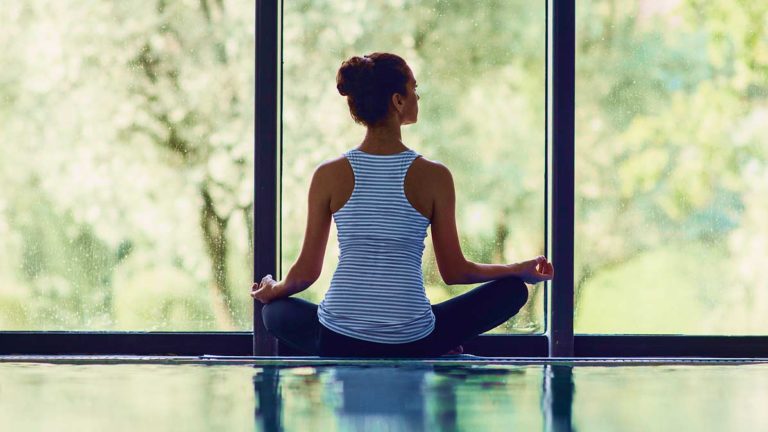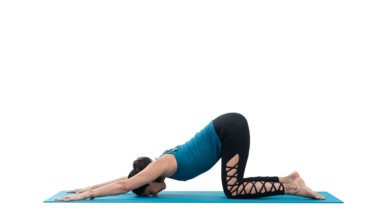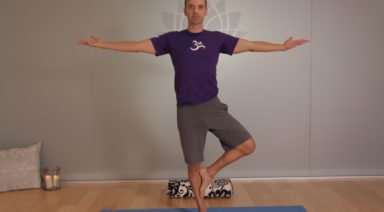Yoga at Home: the Intimate Experience of Self-Practice

There are a lot of reasons to begin a home practice, but one of the most rewarding is the way a dedicated sadhana, or practice, can make anywhere you unroll your mat feel like home. And while nothing quite compares to the live transmission of a living, breathing teacher, there is an unparalleled intimacy that grows out of self-guided practice. Not to mention the opportunity to drop into a personal connection with the divine while eluding the modern obstacles of schedule, cost, convenience, availability, travel time, etc. But before we get into the details of how to practice yoga at home, let us consider for a moment what yoga is.
Yoga is not something you do, it is something you are.
With a more practical explanation, Leslie Kaminoff says any time your body, your breath and your mind are doing the same thing at the same time, you are in a state of yoga. Please don’t get me wrong, the clarity of this message need not take away from the infinite depth of what is a lifelong practice. However, yoga can be plainly understood as a state of union where all the fragmented parts of ourselves — physical, mental, emotional, spiritual — coalesce into a singular experience of the present moment. With that understanding, it is possible (and important) to feel the freedom of being yoga anywhere, especially at home.
When you can experience yoga at home, you have the potential to live your yoga every single day — whether you’re a seasoned practitioner with memberships to studios all over town or someone nurturing the initial seeds of curiosity. My humble intention here is to share what I’ve learned in my personal, sometimes messy, exploration of the art of home practice.
Create Sacred Space
For many, myself included, creating a space that feels sacred at home can be challenging, especially for those of us living in tiny places or those who travel regularly. The trick is to get creative. Have you ever heard the concept that you shouldn’t work where you sleep? The thought is you will inevitably have trouble sleeping because your body and mind are conditioned to work in that place. The same goes for yoga at home; it is difficult to practice in a space that still feels like it’s purposed for something else. This doesn’t mean you have to clear out an entire room or even a whole corner for your mat. What it does mean is, there must be something about the space (internal or external) that is different.
There must be something about the space that shifts your awareness into practice mode.
Something that doesn’t tempt you to multitask or become distracted. Perhaps it’s something physical, like an image or an ornament. Perhaps it’s something you say or something you do. It could be something you take out, like your mat or something you put away, like your phone. Whatever it is, it should elicit the transition to yoga. No matter how simple this “something” is, it will evolve over time into your personal ritual of cultivating sacred space.
Before I had a dedicated home practice, I used my mat for everything from post-run stretching to a pillow for watching movies and a blanket for picnics. Naturally, when I laid my mat out for practice, everything about the space I created was distracting. The energy, the smell, the miscellaneous crumbs that inevitably gathered. Needless to say, there was no yoga. With continual refinement, I am beginning to understand what it takes for me to create sacred space. For me, it is largely about internal space because over the years, I have practiced in many external spaces — apartments and kitchen floors, hotel rooms and airports, guest rooms and backyard patios…now the hallway of a travel trailer.
In addition to a conscious internal shift, I also have a traveling altar that comes with me everywhere I go.
It’s a small wooden statue of two humans carved into a whole-body embrace. It reminds me why I practice as a symbol of union and it represents the relationships that are important to me. The weathered wood gently encourages the patience of daily sadhana and brings the sustaining power of Gaia (the great mother) to my mat. With this pocket-sized altar that I can use anywhere, there are just a few more things that I take into consideration before practicing:
Time
In the early stages of practicing yoga at home, time was the biggest obstacle for me. Operating from measurement mentality, I felt as though I needed to be on my mat for at least an hour for it to qualify as practice. The reality is, sometimes carving an hour out of your day isn’t feasible and too readily becomes a reason not to practice. Instead, I suggest committing to a sustainable amount of time, be it 20 minutes or 2 hours, and then just begin. All you have to do is show up one day at a time.
Light
If possible, find a space that allows you to sense the presence of natural sun or moonlight. Consider practicing during sandhya , such as sunrise, sunset, or other times that attune your body’s circadian rhythm to the natural rotation of the earth.
Orientation
Align your internal compass with the cosmos by purposefully choosing the direction you face. Are you in a cycle of completion where you want to feel the energy of the sun to your back? Or maybe in a period of growth where you want to experience the illumination that lies ahead? Let everything about the space you create be done on purpose.
Leverage Available Resources
It’s practice time. You showed up, you unrolled your mat and you’re standing in your uniquely sacred space. Now what? Perhaps even more challenging than figuring out where to practice yoga at home is figuring out what to do — especially if you are new to yoga. In the beginning, regardless of your experience level, it is helpful to have the expert guidance of a teacher and for those of us wanting to explore yoga at home, we are in luck! For modern-day practitioners, there are countless resources that bring the wisdom of yoga teachings into our homes. The trouble is, when you are first entering into the flow of daily home practice, it can be time-consuming and potentially distracting to find a new online yoga video or guided sequence for each day. Instead of searching endlessly for the perfect class every time you want to practice, try instead limiting yourself to a video or sequence for each of the following practice formats:
Solar and Lunar Practices
Solar practices are energizing; lunar practices are meditative. Select onelong and one short for solar and one long and one short for lunar.
In the beginning, you can experiment with resources until you find the right fit for each case, but once you have figured out your go-to sequences in these four categories, stick with them for a month or so. Take a few moments before each practice to evaluate your energy level and receive information from your body, then choose your flow accordingly and enjoy. After a month of devoted practice, you might recalibrate and move onto something different or you may continue to experience the unfolding of new insights with iteration.
Wise Practice
In the absence of a live teacher, we must step powerfully into the freedom and responsibility that accompanies self-practice. This involves navigating our intuitive edges with a deep respect for this one body that we are given as we engage in wise practice.
Play the Long Game
A dedicated sadhana can contribute to health and longevity if we simply take our time. Yoga is a lifelong practice that can indeed carry us into old age if we have the patience to let it. With the long game in mind, welcome the simplicity of being more by doing less. What if you spent a whole practice dynamically exploring the energy and mechanics of a single “easy” pose? Sometimes, the “easy” poses are the greatest teachers because as Christina Sell says, “if you consistently make the easy poses hard, the hard poses do get a lot easier.”
Pain is an Intuitive Force
Our bodies are built with a number of self-preservation mechanisms that are designed to keep us alive and well. Pain is one of them, but yoga is not painful. Uncomfortable, challenging, ego-checking, and scary, yes. But not painful. The best time to stop is before pain arises, but in the event that you experience a tweak, a pinch or a twinge, breathe and slowly exit the pose. Give yourself several moments to experience the sensation and evaluate before moving on.
Breathe, Dear Human!
One of the best ways to avoid injury while practicing yoga at home is to pay attention to your breath. Everything you need to know about your internal landscape is embedded in your breath. Notice the effect on your mind when your breathing is shallow and irregular as compared to a smooth, steady flow. Notice the fluctuations as they relate to movement and listen carefully for labored or restricted breathing as it could be a sign of fatigue and is generally an indication that you’ve gone too far. When the breath goes, so does the yoga.
“Whenever you are in doubt, it is best to pause. Few things are so pressing that they cannot wait for a moment of breath.”
T.K.V. Desikachar
Be Your Own Energy Alchemist
When we commit to a devoted practice of yoga at home, we get to choose our own adventure with each new arrival on the mat. Simply going through the motions is no longer an option because when the practice isn’t serving us on a particular day, we have the power to change it. This how we become energy alchemists. Alchemy is “a seemingly magical process of transformation, creation or combination” and as alchemists, it is up to us to combine different elements of the practice to yield our desired transformation.
Your Personal Practice Rhythm
As Pranic beings, our energy levels may be affected by everything from the book we are reading to the weather. However, as you begin to enjoy yoga at home more regularly, you may begin to perceive the subtle underlying patterns in your body as they relate to different days and times. In my practice, for example, Tuesdays are generally my courageous heart, nothing-can-stop-me, bring on the week, days. Conversely, Mondays are typically much quieter and it takes a lot more energy just to get my body moving.
As a result, I typically start my week on Tuesdays, which happens to suit my fluid schedule. Similarly, when I know I have a busy day ahead, I try to wake up a little early and move through at least 5 Surya Namaskar A and 5 Surya Namaskar B to keep yoga alive in my body in the event that I’m unable to squeeze in a practice elsewhere. The idea is to let whatever rhythm you choose provides the energy alchemy that serves you best.
Balance in Contrary Complements
We all have our favorite categories of asana and even if you’re in the nascent stages of yoga practice, yours will reveal themselves soon. As such, we organically gravitate toward the shapes that fit into these categories (backbends, twists, hip openers, etc.) because they feel good in our bodies. We must, however, also spend time with the asanas that we don’t love. Those that we are rekindling a relationship with or those we have yet to meet. Are you a lover of backbends? Try simmering in deep forward folds.
Naturally flexible? Explore ways to develop muscular strength and endurance. We have as much to learn from pratikriyasana (reverse action) as we do from the fullest expression of any posture. Despite what poses we think we should practice, it is prudent also give adequate devotion to the shapes we shy away from and inside that devotion, ask the question: why?
Set Intentions, Not Goals
I will be the first to admit, I am a strong proponent of goal-setting, goal-chasing, and overall goal-related enthusiasm. In most circumstances, I believe setting measurable goals and declaring them aloud is like saying to the Universe, “I mean it, I really want this”. The mat, however, is one place that I prefer to keep metric-free. In my experience, a practice that is rooted in the desire to achieve an external pose or aim does not sustain me long-term and keep me coming back for more. If the aim is too challenging,
I have a tendency to become discouraged. Too easy and I will likely become disinterested. Intentions, on the other hand are living, breathing forces of consciousness. Our relationship with them changes and evolves giving them the potential to surprise in new, wonderful ways all the time. Consider how inviting courage onto your mat might get your feet off the ground in crow pose one day and give you the permission to rest in child’s pose the next. With their infinite forms, intentions are better equipped to support the purpose of ongoing sadhana.
Let Your Yoga Move You On the Mat and in the World
Once you have established the basic structure of your practice, it’s time to get creative. Over time, you might find that you rely less and less on what you have planned and more on what your body, better yet your spirit, needs. The root format that you put in place becomes a mere container in which to grow your signature style. The container is important though, it allows you to feel safe and taken care of on your mat.
Tandava: The Cosmic Dance
While living in Japan, I had a Japanese student who used to refer to “playing yoga”. For her, the translation from Japanese to English was the same as “playing tennis” or “playing hockey”. Even though I was her teacher, I struggled to correct her because “playing yoga” seemed to capture the spirit of the practice more astutely. It is from her that I learned the value of play in self-practice. At the end of the day, your home practice should be playful and fun. I encourage you to experiment with different movement modalities such as dance, athletics, martial arts, and the things you see children and animals do. Observe how these expressions can serve as outlets for your primal creative energy and life force. The cosmic dance has no form, it simply calls us to move the way spirit moves.
Satguru: The Divine Teacher Within
Some of the biggest ah-ha! moments that I have experienced on the mat have happened during my home practice when there’s no one around to high-five. This is by design. Yoga does not require an audience to be deeply satisfying. When we open to the teaching available within our own embodiment, we are receiving a direct transmission of consciousness. This is the intelligence of Sat Guru in action. You’ll know it when it happens because it feels like something falling into place or like something new awakening. We can learn so much about alignment and the movement of prana by simply paying attention.
Living
As you nurture your home practice, you begin to understand that self-care is not selfish. The greater capacity you develop for self-compassion and self-love inside the refuge of your home practice, the more abundance you will have of these energies for those around you. This is living Namaste as we begin to see all the highest versions of ourselves reflected in others. Similarly, when confronted with challenging personalities, we do not experience them as separate and deserving of blame. Instead, we see our own struggle reflected in theirs and discover a reserve of kindness.
SOLITUDE AND YOGA: DISCOVERING THE VALUE OF A HOME PRACTICE

Many people say yoga has changed their lives, myself included. I started practicing in New York City, a place that has the potential be a yogi’s dream. There are expensive studios with a view, free yoga in the park, donation based studios, and celebrity instructors. You can find Kundalini, Bikram, [Ashtanga]/style/ashtanga-yoga}, power yoga, etc. You name it and New York probably has it. It’s something of a phenomenon there, often marketed as the preferred method of escape from the crazed city lifestyle.
I’d be lying if I said I didn’t enjoy my time in the fancy studios. I did. I looked forward to drinking my eight dollar green juice while heading to the studio that I paid an exorbitant amount of money to every month. The lululemon was on, toenails painted, and hair in a proper ponytail. In class I would try my hardest to nail that handstand, to remain in crow for longer than five seconds, and to ensure my stomach was constantly sucked in. At times I pushed my body passed where it was ready to go. While I knew this was a result of my vanity and my own issues, and not the fault of the studio, I was missing the most important aspect of yoga. I lacked the connection to self, the willingness to let go and just be and observe. While I knew there were people in my class who were able to block the outside world out (and I salute them for that), I also knew there were others who had experienced, and continued to feel the same fears and discomfort, that I felt.





































